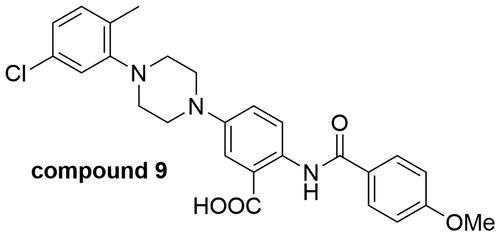当前位置:
X-MOL 学术
›
J. Med. Chem.
›
论文详情
Our official English website, www.x-mol.net, welcomes your feedback! (Note: you will need to create a separate account there.)
Discovery of Anthranilic Acid Derivatives as Difluoromethylornithine Adjunct Agents That Inhibit Far Upstream Element Binding Protein 1 (FUBP1) Function
Journal of Medicinal Chemistry ( IF 7.3 ) Pub Date : 2022-11-16 , DOI: 10.1021/acs.jmedchem.2c01350 Aiste Dobrovolskaite 1 , Holly Moots 1 , Mukund P Tantak 1 , Kunal Shah 1 , Jenna Thomas 1 , Sharifa Dinara 1 , Chelsea Massaro 1 , Paul M Hershberger 2 , Patrick R Maloney 2 , Satyamaheshwar Peddibhotla 2 , Eliot Sugarman 2 , Sally Litherland 3 , Juan Pablo Arnoletti 3 , Rajiv Kumar Jha 4 , David Levens 4 , Otto Phanstiel 1
Journal of Medicinal Chemistry ( IF 7.3 ) Pub Date : 2022-11-16 , DOI: 10.1021/acs.jmedchem.2c01350 Aiste Dobrovolskaite 1 , Holly Moots 1 , Mukund P Tantak 1 , Kunal Shah 1 , Jenna Thomas 1 , Sharifa Dinara 1 , Chelsea Massaro 1 , Paul M Hershberger 2 , Patrick R Maloney 2 , Satyamaheshwar Peddibhotla 2 , Eliot Sugarman 2 , Sally Litherland 3 , Juan Pablo Arnoletti 3 , Rajiv Kumar Jha 4 , David Levens 4 , Otto Phanstiel 1
Affiliation

|
Polyamine biosynthesis is regulated by ornithine decarboxylase (ODC), which is transcriptionally activated by c-Myc. A large library was screened to find molecules that potentiate the ODC inhibitor, difluoromethylornithine (DFMO). Anthranilic acid derivatives were identified as DFMO adjunct agents. Further studies identified the far upstream binding protein 1 (FUBP1) as the target of lead compound 9. FUBP1 is a single-stranded DNA/RNA binding protein and a master controller of specific genes including c-Myc and p21. We showed that 9 does not inhibit 3H-spermidine uptake yet works synergistically with DFMO to limit cell growth in the presence of exogenous spermidine. Compound 9 was also shown to inhibit the KH4 FUBP1–FUSE interaction in a gel shift assay, bind to FUBP1 in a ChIP assay, reduce both c-Myc mRNA and protein expression, increase p21 mRNA and protein expression, and deplete intracellular polyamines. This promising hit opens the door to new FUBP1 inhibitors with increased potency.
中文翻译:

发现邻氨基苯甲酸衍生物作为二氟甲基鸟氨酸辅助剂抑制远上游元素结合蛋白 1 (FUBP1) 功能
多胺生物合成受鸟氨酸脱羧酶 (ODC) 调节,该酶由 c-Myc 转录激活。筛选了一个大型文库,以找到增强 ODC 抑制剂二氟甲基鸟氨酸 (DFMO) 的分子。邻氨基苯甲酸衍生物被确定为 DFMO 辅助剂。进一步的研究确定了最上游的结合蛋白 1 (FUBP1) 作为先导化合物9的靶标。FUBP1 是一种单链 DNA/RNA 结合蛋白,也是 c-Myc 和 p21 等特定基因的主控制器。我们证明9不会抑制3 H-亚精胺的摄取,但与 DFMO 协同作用,在外源亚精胺存在的情况下限制细胞生长。化合物9还在凝胶迁移测定中抑制 KH4 FUBP1-FUSE 相互作用,在 ChIP 测定中与 FUBP1 结合,减少 c-Myc mRNA 和蛋白质表达,增加 p21 mRNA 和蛋白质表达,并消耗细胞内多胺。这一充满希望的成果为开发效力更强的新型 FUBP1 抑制剂打开了大门。
更新日期:2022-11-16
中文翻译:

发现邻氨基苯甲酸衍生物作为二氟甲基鸟氨酸辅助剂抑制远上游元素结合蛋白 1 (FUBP1) 功能
多胺生物合成受鸟氨酸脱羧酶 (ODC) 调节,该酶由 c-Myc 转录激活。筛选了一个大型文库,以找到增强 ODC 抑制剂二氟甲基鸟氨酸 (DFMO) 的分子。邻氨基苯甲酸衍生物被确定为 DFMO 辅助剂。进一步的研究确定了最上游的结合蛋白 1 (FUBP1) 作为先导化合物9的靶标。FUBP1 是一种单链 DNA/RNA 结合蛋白,也是 c-Myc 和 p21 等特定基因的主控制器。我们证明9不会抑制3 H-亚精胺的摄取,但与 DFMO 协同作用,在外源亚精胺存在的情况下限制细胞生长。化合物9还在凝胶迁移测定中抑制 KH4 FUBP1-FUSE 相互作用,在 ChIP 测定中与 FUBP1 结合,减少 c-Myc mRNA 和蛋白质表达,增加 p21 mRNA 和蛋白质表达,并消耗细胞内多胺。这一充满希望的成果为开发效力更强的新型 FUBP1 抑制剂打开了大门。



























 京公网安备 11010802027423号
京公网安备 11010802027423号